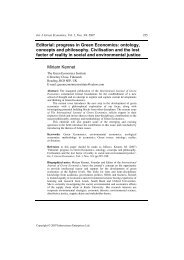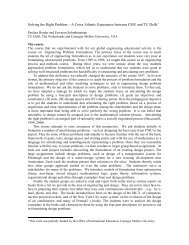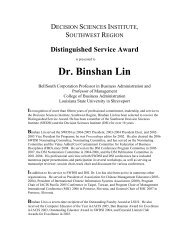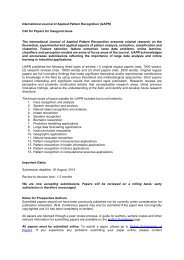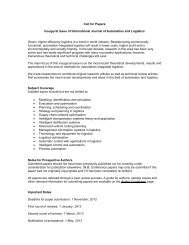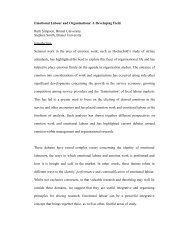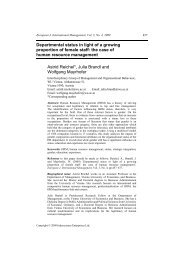A new Zeitgeist for international business activity and ... - InderScience
A new Zeitgeist for international business activity and ... - InderScience
A new Zeitgeist for international business activity and ... - InderScience
You also want an ePaper? Increase the reach of your titles
YUMPU automatically turns print PDFs into web optimized ePapers that Google loves.
286 J.H. Dunning<br />
Table 2 The human environment (CIRCA 2007)<br />
General<br />
More volatility/insecurity/complexity in a world in which future events are becoming<br />
increasingly unpredictable<br />
Need <strong>for</strong> more/different extra market institutions to contain or reduce transaction costs<br />
Changing intentions, values, belief systems of individuals <strong>and</strong> organisations<br />
Formal/in<strong>for</strong>mal incentive structures <strong>and</strong> en<strong>for</strong>cement mechanisms<br />
The role of institutions in legitimising corporate behaviour: institutional relatedness<br />
Bottom up → top down institutions<br />
Why institutions are often resistant or slow to change: the issue of path dependence<br />
IB specific<br />
HEs of particular countries less easy to transfer outside their home territories<br />
Harmonising multiple cross-border human environments<br />
Coping with different customs, ideologies, incentive structures, raise transaction costs<br />
Transnational institutional building <strong>and</strong> governance systems<br />
Implications of global integration of production systems <strong>for</strong> mindsets of managers of MNEs<br />
(<strong>and</strong> their subsidiaries)<br />
Widening the sphere(s) of global governance<br />
These institutions may be <strong>for</strong>mal (e.g., constitutions, law <strong>and</strong> regulations); or in<strong>for</strong>mal<br />
(e.g., tradition, custom, voluntary codes or conduct). They may per<strong>for</strong>m an in<strong>for</strong>mative,<br />
guiding, constraining or enabling function. They may affect both the intentions <strong>and</strong><br />
values of decision takers. They may be national or multinational in origin <strong>and</strong>/or scope.<br />
They may take the <strong>for</strong>m of top down instruments (e.g., governments requiring firms to be<br />
more transparent in their financial reporting) or bottom up instruments (e.g., consumers<br />
boycotting purchasing from firms they believe are behaving unethically). Institutional<br />
change may result from a reconfiguration of either <strong>for</strong>mal rules or in<strong>for</strong>mal norms – or,<br />
more likely, from a combination of each. Likewise, en<strong>for</strong>cement mechanisms may range<br />
from self-imposed codes of behaviour, the ability (<strong>and</strong> likely willingness) of those<br />
adversely affected to retaliate, <strong>and</strong> penalties, sanctions, (sticks) or tax et al. incentives<br />
(carrots) imposed by governments (North, 1990, 1994, 1999, 2005).<br />
“If culture is the mother, institutions are the children”, wrote Etounga-Manguelle<br />
(2002, p.75): <strong>and</strong> North himself accepts that the culture of a society comprises the<br />
“structure of rules <strong>and</strong> beliefs it inherits from the past, shape our present <strong>and</strong> influence<br />
our future”, (North, 1999, p.15). Certainly institutional artefacts are the main instruments<br />
by which the processes of value creation <strong>and</strong> value capture are legitimised <strong>and</strong><br />
determined. Markets can only per<strong>for</strong>m their true function if they abide by a set of rules or<br />
guidelines which either the market participants or extra-market governance entities, or<br />
both, may set. Thus the managers of firms may be constrained in any profit maximising<br />
strategy by shareholders insisting that they conduct their activities in a socially<br />
responsible manner. Democratic governments, <strong>for</strong> their part, may be held responsible, by<br />
their electorates, <strong>for</strong> the incentive structures they design <strong>and</strong> implement. Supranational<br />
entities often find their market facilitating strategies thwarted by the advocacy of, or<br />
action by, particular interest groups. Each <strong>and</strong> every one of these examples sets the




